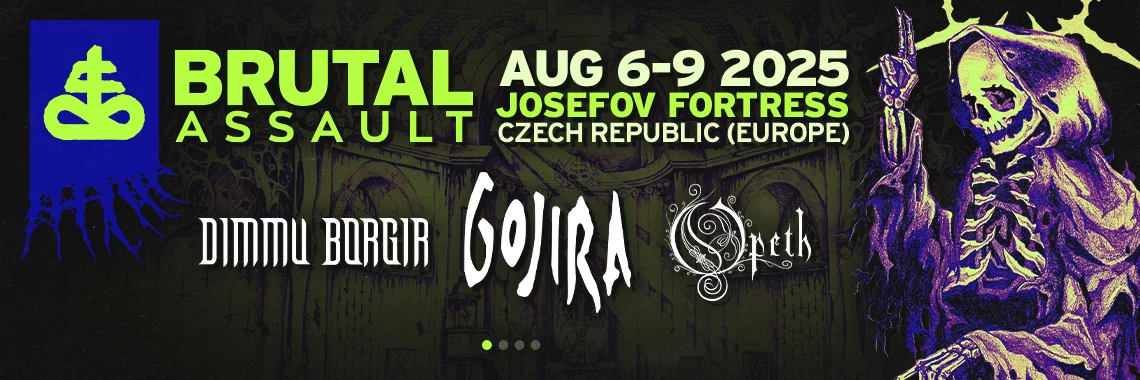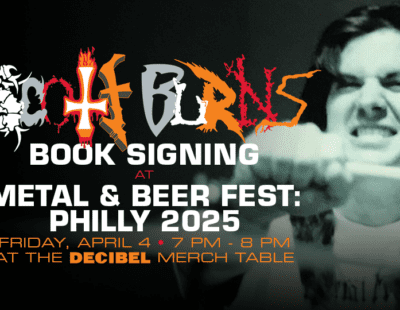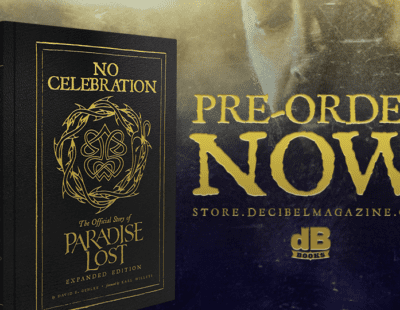
As if it’s not obvious, we’re big fans of Dayal Patterson here at Decibel. Along with releasing the American printing of “Black Metal: The Cult Never Dies Vol. 1”, we try to keep in touch with him whenever he’s got a new book out. And while he’s rightly known for “Black Metal: Evolution of the Cult,” Dayal’s begun to branch out into other styles of music and other mediums relevant to extreme metal.
To that end, he’s been working on a book with artist David Thiérrée. David is the man behind several album covers, including Behemoth’s first two albums and Mütiilation’s “Remains of a Ruined, Dead, Cursed Soul.” The book is called “Owls, Trolls & Dead Kings’ Skulls: The Art of David Thiérrée” and will be out on May 31 via Cult Never Dies.
To learn more about David’s work and what makes his style come to life, I asked him some questions (answers contain light editing for clarity):
What first drew you to the visual arts? Was it a desire to emulate other artists, or something that naturally sprang from your interests?
This is something you have inside of you since longer than you can remember. Kids always draw, but not all continue after their teenage years. If more and more kids keep drawing nowadays and post anything they do on the web, it’s because they were told they were special, and that almost everything they did was probably worthy of the biggest interest, but that’s another matter.
To draw has always been a paramount need, so I can’t see myself doing something else. As a musician plays music, I draw and paint. But among musicians, you have those who play other people’s music, and those who compose music from scratch. Even if the composer is learning by playing others’ music, he composes as soon as he handles the instrument, or craves for it. This was nearly the same for me. I began to draw as any other kid, and kept drawing, tried to improve by drawing superhero comics, trying to draw comics myself, drawing birds, cars, boats, landscapes, money bills, portraits, etc, while trying to apply what I learned to personal pieces. This is something you can’t really control, you must draw, draw and draw again.

In a similar vein, what drew you to black metal and extreme music?
It’s a long story, developed in the book, a long path, from classical hard rock and heavy metal, to more and more extreme music, throughout the 80’s. To summarize things a little, it’s a natural taste for everything that could put me out of the crowd, and more and more somber and violent sounds. Besides heavy metal, I listened a lot to new wave, cold wave, industrial music, etc… but also folk and medieval music. Black metal seemed like a natural favorite, as it merges a lot of aspects of the above-named styles, both musically and visually.
Discovering black metal (through Bathory, Venom and Celtic Frost at first, then with Beherit, Master’s Hammer, Samael and Darkthrone later) was quite an epiphany, later confirmed by such bands as Ulver, Enslaved, Emperor, etc… that, to my taste, were exactly what I needed to really dig inside my mind and imagination, to do what I do today. Without black metal, I would not be here talking to you. Not only because I dwelled and work in this milieu, but because this music made me who I am today.
How did you get started doing album artwork for bands like Behemoth? Are you still in touch with any of those bands?
I’m still in touch with Nergal, and some other people from the early 90’s, yes. Those people have a good memory and don’t forget people that easily. Some people I’ve never ceased to stay in touch with, some relations with some eclipses, but most of them never forgot we were in touch once, and most of the time we still are. It’s funny sometimes to see that, after 20 years, you can work with a band again. We’ve been through tape-trading, snail mail with glued stamps, soulseek, old internet, Myspace, Facebook, and now sometimes we meet at festivals.
I started as a vocalist in a death metal band that I joined in 1989. I made their logo and demo covers, and we started to spread our music. We had some nice feedback, including mentions of the artwork. Some fanzines and labels asked if I could do some more, and I gladly accepted. Later, I began to spread some flyers to promote my work, getting more feedback, and so on. This was another time, before the internet, cheap computers and scanners. Everything was made the hard way, every fan and deal earned with effort and patience. Sometimes people seem to forget how hard it was, how much energy and time it took to build some good relations with people afar, without seeing their faces or knowing anything about how they live, their struggles, etc… Nothing to compare with Facebook times.

A lot of your artwork seems inspired by themes in literature and folklore, do you have any books or stories in particular that you like to draw on for inspiration?
My work is partly made of folklore and the idea I have of folklore. It’s a bit tricky to explain, but even if I read a lot of folk tales, I like to keep a part of my own phantasms, the idea I have of folk tales, and the archetypes of imaginary worlds and characters. I love troll tales, but I need to have enough space inside to create my own troll, linked to no story in particular, just here to be a part of a story, fixed on an image. I like people to make their own story, or link my image to the story they will fancy.
By the way, some tales are really vague, more like some kind of experiences out of consciousness, where you can’t tell which part is dreamt and which one is reality (or at least the reality created by the story). Most stories have a strong moralist essence, or simply glorify some qualities and virtues. In themselves, those stories are not drawing material. But they possess a imagery, some scenes described that are like visions. To keep the subject on trolls, I imagine hills or mountainsides that you can walk upon during the day, and do harmless pasture, but that, under the moonlight, move and become alive. Those troll-hills can walk and talk, gather above a lake, their moonlit eyes catching the stars, watching the space above, howling raucously, breaking trees and stomping the earth.
There are more stories, visions and feelings of a time forgot, the nostalgia of something I never lived.
Along with the book collaboration with Dayal, what are some current projects you have going?
Well, nothing more than making new art. I have plenty of cover artwork to do. I need to promote the book also at Metal Festivals to make it a success. Besides that, I plan to move to Norway this summer for an exhibition and maybe the USA in a year or two. I’ve visited your lovely country many times, and I would like to visit once again. I would like to put my hands again on sculpture, try harder woodcut printing, going back on oil painting, make some personal pieces, make some more trolls, start cultural projects and collaborations in Scandinavia, Germany and of course England, where I strongly need to visit again. I would like to draw more nature and animals, create some limited series of cards and prints, sold leather-bound, with badges and other tokens, create wooden boxes and trinkets, a board game based upon the images and worlds I explore in my works… Well, I need more than a life to do all this.
—
“Owls, Trolls & Dead Kings’ Skulls: The Art of David Thiérrée” is currently available for pre-order at Cult Never Dies!






